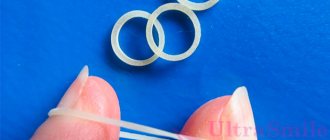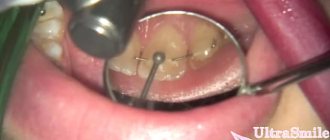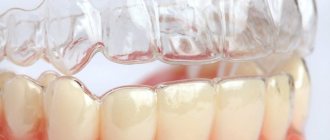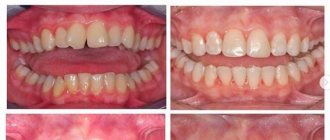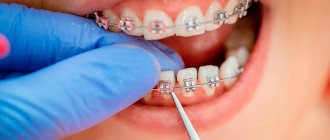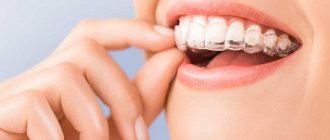Malocclusion is one of the most common problems of the dental system. More than 80% of patients have malocclusion, expressed in one form or another. In many cases, the pathology is not pronounced and generally does not cause aesthetic discomfort to the patient, so the patient is in no hurry to correct the bite in dentistry. It is important to understand that bite problems, even the most minor ones, must be corrected, since any anomaly affects the normal functioning of the entire dental system.
Why do you need a dental guard after braces?
Braces correct the bite. This may take several months or even years. When the orthodontic appliance is finally removed, the patient experiences relief. But not everyone knows that after removing braces, teeth can return to their previous incorrect position. This is due to the structural features of the jaw and the physiology of the body, for which it is natural to resist outside interference.
In this article
- Why do you need a dental guard after braces?
- Types of removable mouthguards
- Advantages and disadvantages of removable aligners
- How is an orthodontic mouth guard installed?
- How long do you wear mouthguards after braces?
- How to care for aligners after braces?
- How to wear mouth guards after braces without damaging them?
- Conclusion
In order to prevent repeated curvature of teeth and to maintain the effect of bite correction achieved during orthodontic treatment, the orthodontist prescribes the patient to wear retainers. These are special structures that are worn during the retention period - a time when there is a risk of the tooth returning to its usual position. Retainers hold the teeth in the desired position and allow the ligaments to “get used” to the new bite.
Retainers are removable and non-removable. The latter are wires fixed on the inside of the teeth. A more convenient and popular option is a removable orthodontic mouthguard - after braces, it is worn only at night.
If there is strong bite resistance, the orthodontist may recommend wearing both removable mouth guards after braces and permanent retainers at the same time. In this case, the wire is worn constantly, and the mouth guard is worn only for a certain time at night or during the day.
A little about bruxism. Why can’t you do without a mouth guard with such a diagnosis?
Bruxism is a disease in which a person clenches their jaws tightly and cannot control the force of their teeth closing.
The problem especially manifests itself at night, when a person is sleeping and does not control the jaw muscles. As a result of such pressure, the teeth are not just worn down, but loosened, the bite is damaged, against which more global dental problems arise, including destruction of the temporomandibular joint. No one is immune from bruxism; the disease can occur:
- due to sleep problems;
- due to increased nervousness;
- against the background of bad habits;
- due to problems with the gastrointestinal tract, etc.
It is important! If left untreated, the disease can lead to serious discomfort, dental problems, and sleep apnea - a pathological breathing disorder during sleep, which is also accompanied by snoring.
Types of removable mouthguards
Dental mouthguards differ in material, duration of wear, and production technology:
- Standard models are made according to one sample and do not take into account the specifics of an individual bite. Therefore, they are rarely used after braces. These types of trays are often used for teeth whitening.
- Thermally modeled retainers. Their peculiarity is that they take the unique shape of teeth after heating. Such a mouth guard is first placed in hot water and only then put on the jaw.
- Individual models are the most accurate and convenient. They are made according to the individual anatomical parameters of a particular patient based on a cast of the jaw.
According to the period of wearing, mouthguards are available at night and around the clock. The first ones are worn exclusively at night and are used in “mild” cases of bite correction. They are worn around the clock, removed only during meals and before oral hygiene. These models are suitable for correcting severe malocclusions.
According to the material, mouthguards can be made of silicone and bioplastic. Both options are distinguished by good hypoallergenic properties, transparency and non-invasiveness.
What tasks does the mouthguard cope with?
A dental mouthguard also performs the following tasks:
- an individual mouthguard provides prevention of dental misalignment;
- helps maintain the integrity of the enamel, and, therefore, reduce the likelihood of developing caries;
- reduces the risk of developing the consequences of bruxism, namely, headaches, pain in the projection of the jaw, which can radiate to the back and neck.
Dentistry for those who love to smile
+7
Make an appointment
Advantages and disadvantages of removable aligners
Caps have many advantages:
- unlike fixed structures, they can be worn for a limited time;
- using mouthguards after braces is more comfortable, since the jaw “rests” from metal structures;
- Oral care is easier if the retainer can be removed.
The main disadvantage of aligners is that they are a noticeable design that affects appearance, so not everyone is ready to wear such retainers during the day. In addition, the design can cause increased salivation.
How is an orthodontic mouth guard installed?
The removable retainer is placed by the orthodontist for the first time; in the future, this can be done by the patient himself. Before the first installation, the doctor prepares the oral cavity for the installation of an orthodontic structure. Checks that the braces system does not damage tooth enamel, evaluates the presence of carious lesions, and covers the teeth with a special protective layer.
A custom-made or thermally modeled mouth guard is placed on the patient's teeth and shown how to remove and put it on independently.
How long do you wear mouthguards after braces?
The most common question that patients ask their orthodontist is how long to wear mouth guards after removing braces. For each person, the wearing period is individual and determined by the doctor. For some, a year is enough to fix the bite; for others, it takes more than two years. If you want to roughly calculate how long you need to wear mouthguards after braces, you can use this conditional formula.
Take as a basis the time during which you wore the braces system and double it. This will be the approximate period of wearing the mouthguard. Many people wear it for two to four years. But there are also people whose muscle memory “refuses to remember” the new position of the jaw; the process of fixing the bite is very slow. In this case, you may need to wear a mouth guard for a longer period, sometimes for life.
Similarities and differences between retention trays and alignment trays
Mouth guards are found quite often in dental practice. There are sports mouth guards, mouth guards for mineralization, for bruxism, retention mouth guards, and for teeth straightening (aligners). They differ in composition, rules of use and areas of application.
Retainers are a necessary stage of treatment after orthodontic correction with braces. If we compare them with aligners, then, despite their external similarity, their functions are radically different. Retention trays are a means of consolidating the result of treatment to hold teeth in a certain position, and aligners are an independent type of orthodontic correction. Both varieties are characterized by transparency, aesthetics and ease of use. Aligners for each person are made individually in quantities of 20-40 pieces and are changed every 2 weeks. Such mouth guards are worn constantly, being removed only when eating and brushing teeth, but retention guards, on the contrary, are worn for several hours day and night, and then only 2-3 times a week.
The period of use of retention guards depends on the patient’s age, characteristics, and clinical case. On average it is 1.5–2 years.
How to care for aligners after braces?
Oral care when wearing orthodontic appliances should be as thorough as possible to avoid caries and other dental damage. Therefore, when installing retainers, the orthodontist must tell the patient how to properly care for the aligners. Below are basic rules for safe cleaning of orthodontic trays and oral care.
The aligners must be removed twice a day during morning and evening brushing. After removing the structure, you must thoroughly brush your teeth with a brush and paste, clean the interdental spaces with floss, floss or irrigator, and remove plaque from the gums, tongue, and inner surface of the cheeks.
The mouthguard itself is also carefully cleaned with a brush and paste, removing plaque and dirt from it. Once every seven days the structure is treated with a special disinfectant. It is also recommended to use mouthwash more often when wearing removable retainers.
Stages
Nausea when brushing your teeth is usually a defensive reaction that is triggered by an irritant, for example, the strong taste of toothpaste. The mechanism of development is quite simple - when cleaning, discomfort is felt, while the person looks at himself in the mirror. A signal is sent to the brain and a reaction develops in the form of vomiting to eliminate the irritant.
The reflex develops through four stages:
- the condition worsens, irritability, fatigue appear, and there is a urge to vomit;
- nausea develops;
- after vomiting there is relief;
- in the intervals between deteriorations, the person feels normal.
How to wear mouth guards after braces without damaging them?
Mouthguards are made of plastic material, so they can be easily damaged if handled carelessly. In this case, the device will no longer perform its main task - to hold the teeth in the correct position. If it breaks, it cannot be repaired; a new one will have to be made. Therefore, it is important to follow the rules of safe operation.
How to wear a mouthguard correctly:
- To avoid damage, it must be removed before each meal.
- Plastic aligners do not withstand high temperatures well, so you should not drink hot tea, coffee or other drinks with an orthodontic structure in your mouth.
- Between uses, the mouthguards are worn like other personal care products - in special lockable containers. This protects the device from contamination and damage.
- You cannot smoke with a mouth guard in your mouth, because tobacco smoke and tar change the color and structure of the material. The mouth guard becomes cloudy and less flexible.
- The structure is stored at room temperature. Both heat and cold negatively affect its characteristics.
Protective mouthguards for teeth
Bruxism is chronic, systematic grinding and grinding of teeth at night or constant clenching and grinding during the day. The causes of bruxism are increased contraction or spasm of the masticatory and temporal muscles. It is also observed with malocclusion, poorly fitted dentures, protruding fillings, which lead to asymmetry in the closure of the dentition. Accompanied by pain in the face, temporomandibular joint, ringing in the ears, increased excitability, and sleep disturbances.
Long-term bouts of bruxism can change the bite, cause joint damage and destroy teeth. Moreover, bruxism can occur in both adults and children, so it is best to eliminate the pathology immediately, without waiting for the teeth and joints to begin to wear out and change irreversibly.
There is an opinion that grinding teeth at night is a “rudiment” left to us from distant ancestors - perhaps this is how they “sharpened” their teeth.
The most effective method of combating bruxism is wearing special occlusal protective mouthguards. These are special plates that fit on the teeth and protect them. The mouthguard is made strictly individually based on a mold of the patient’s teeth. Its main goal is to prevent teeth from being worn down during an attack of bruxism. Instead of teeth, the mouthguard itself will be worn away. It can also protect joints that may become deformed and the integrity of crowns, bridges and inlays.
For each patient, their own mouth guard is prepared, which can be day or night
To protect teeth from bruxism during the day, special splints are used that can be worn constantly. The tire is placed in the depths and remains invisible to others. It is invisible to others, does not interfere with eating, talking and smiling.
Night guards cannot be worn around the clock; they are intended to protect teeth only during sleep, when a person cannot control teeth grinding on their own. It is important to know that a mouthguard does not eliminate the cause of bruxism, but only prevents damage to the teeth.
Making these special trays takes 3-4 days and two visits to the dentist. At the first visit, the specialist will make an impression of the teeth, and at the next visit the finished product can be picked up.
If bruxism persists for a long time in an adult, then it is necessary to treat all teeth or bite defects. You can also contact a specialist in maxillofacial surgery to discuss the issue of relieving hypertonicity of the masticatory muscles.
As an additional treatment for bruxism, it is recommended to use B vitamins and drugs that contain magnesium and calcium. This will help reduce the activity of the masticatory muscles at night during sleep.
To make a custom mouthguard to protect your teeth from attacks of bruxism, you can make an appointment with an orthopedic dentist or orthodontist for a preliminary consultation and taking impressions.
